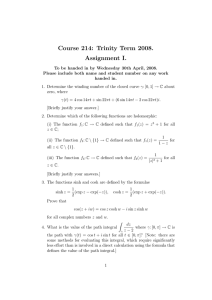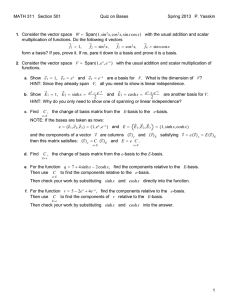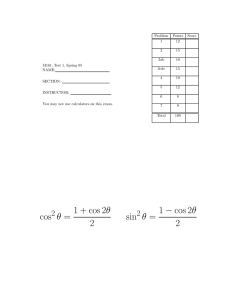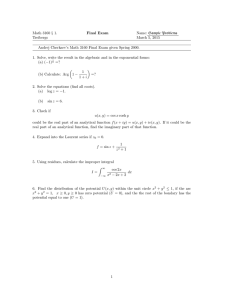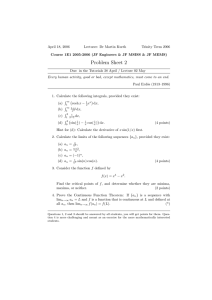PX408: Relativistic Quantum Mechanics Tim Gershon () More selected worked answers
advertisement
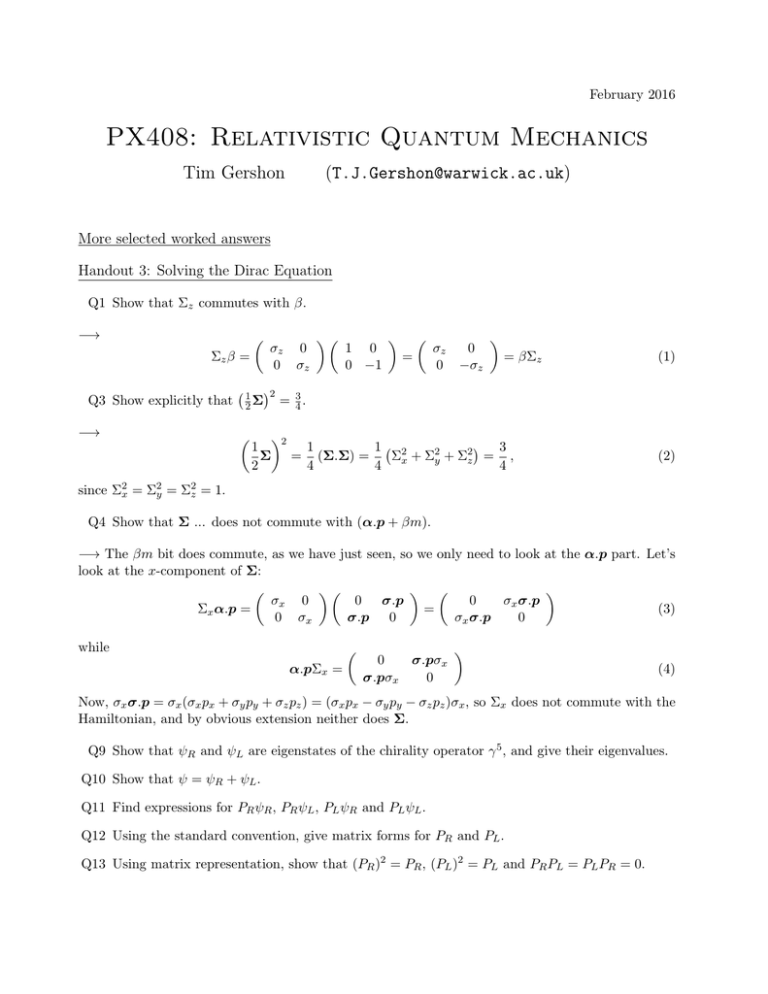
February 2016 PX408: Relativistic Quantum Mechanics Tim Gershon (T.J.Gershon@warwick.ac.uk) More selected worked answers Handout 3: Solving the Dirac Equation Q1 Show that Σz commutes with β. −→ Σz β = Q3 Show explicitly that σz 0 0 σz 2 1 2Σ −→ 1 0 0 −1 = σz 0 0 −σz = βΣz (1) = 43 . 2 3 1 1 1 2 Σ = (Σ.Σ) = Σx + Σ2y + Σ2z = , 2 4 4 4 (2) since Σ2x = Σ2y = Σ2z = 1. Q4 Show that Σ ... does not commute with (α.p + βm). −→ The βm bit does commute, as we have just seen, so we only need to look at the α.p part. Let’s look at the x-component of Σ: 0 σx σ.p σx 0 0 σ.p (3) = Σx α.p = σx σ.p 0 0 σx σ.p 0 while α.pΣx = 0 σ.pσx σ.pσx 0 (4) Now, σx σ.p = σx (σx px + σy py + σz pz ) = (σx px − σy py − σz pz )σx , so Σx does not commute with the Hamiltonian, and by obvious extension neither does Σ. Q9 Show that ψR and ψL are eigenstates of the chirality operator γ 5 , and give their eigenvalues. Q10 Show that ψ = ψR + ψL . Q11 Find expressions for PR ψR , PR ψL , PL ψR and PL ψL . Q12 Using the standard convention, give matrix forms for PR and PL . Q13 Using matrix representation, show that (PR )2 = PR , (PL )2 = PL and PR PL = PL PR = 0. −→ γ 5 ψR,L = γ 5 1 1 5 1 ± γ5 ψ = γ ± 1 = ±ψR,L , 2 2 (5) where we have used (γ 5 )2 = 1. Hence ψR,L are eigenvectors of the helicity operator γ 5 with eigenvectors ±1 (+1 for ψR and −1 for ψL ). ψR + ψL = 1 1 1 + γ5 ψ + 1 − γ5 ψ = ψ 2 2 PR ψR = = = PR ψL = = 1 2 1 4 1 2 1 2 1 4 (6) 1 1 + γ5 ψ 2 1 + 2γ 5 + (γ 5 )2 ψ 1 + γ5 (7) (8) 1 + γ 5 ψ = ψR (9) 1 1 − γ5 ψ 2 5 2 1 − (γ ) ψ = 0 1 + γ5 (10) (11) Similarly PL ψR = 0 and PL ψL = ψL . PR = PL = 1 1 1 1 1 0 1 1 0 = + 1 + γ5 = 1 0 0 1 2 2 2 1 1 1 1 1 0 1 1 0 1 −1 5 = − 1−γ = 1 0 0 1 2 2 2 −1 1 (PR )2 = (PL )2 = PR PL = 1 4 1 4 1 4 (13) 1 1 1 = PR 2 1 1 1 1 −1 1 −1 1 −1 = = PL −1 1 −1 1 2 −1 1 1 0 0 1 1 1 −1 = = 0 = PL PR 1 1 −1 1 2 0 0 1 1 1 1 (12) 1 1 1 1 = Q16 By giving the non-relativistic expression for E, find the limit of σ.p E−m (14) (15) (16) as |p| → 0. −→ Non-relativistic: E = m + |p|2 /2m so E − m = |p|2 /2m. So the denominator of zero faster than the numerator, and the limit goes to infinity. σ.p E−m goes to Q17 What are the values of ū(p, s)u(p, s) and v̄(p, s)v(p, s)? Q18 What are the values of ū(p, s)γ 5 u(p, s) and v̄(p, s)γ 5 v(p, s)? −→ 1/2 u(p, s) = (E + m) † 0 −→ ū(p, s) = u(p, s) γ 1/2 = (E + m) φs σ.p s (E+m) φ † s † s † σ .p (φ ) − (φ ) (E + m) (17) (18) so that † s † s s † σ .pσ.p s ū(p, s)u(p, s) = (E + m) (φ ) φ − (φ ) φ . (E + m)2 (19) The definitions of the Pauli matrices are such that σi† = σi (i.e. they are Hermitian), and hence p2 2m s † s = (E + m) ū(p, s)u(p, s) = (E + m)(φ ) φ 1 − = 2m , (20) 2 (E + m) E+m using (φs )† φs = 1. Similarly s † s v̄(p, s)v(p, s) = (E + m)(χ ) χ p2 −1 (E + m)2 = −(E + m) 2m = −2m . E+m † 0 1 s † s † σ .p ū(p, s)γ u(p, s) = (E + m) (φ ) − (φ ) 1 0 (E + m) = σ.p (φs )† φs − (φs )† φs = 0 . 5 φs σ.p s (E+m) φ (21) (22) (23) Similarly v̄(p, s)γ 5 v(p, s) = 0. Q19 Find the solution to ... −→ cos θ −i sin θ i sin θ − cos θ a b = a b (24) i.e. a(cos θ − 1) − ib sin θ = 0 (25) ia sin θ − b(cos θ + 1) = 0 b2 −→ a(cos θ − 1) − (cos θ + 1) = 0 a (26) (27) It’s is convenient to write this in terms of 2θ , using the trigonometric identities cos 2θ = cos2 θ − sin2 θ and sin 2θ = 2 sin θ cos θ. A little bit of rearranging then gives the following expression: −2a2 sin2 θ θ − 2b2 cos2 2 2 = 0, (28) which can be solved together with the normalisation condition |a|2 + |b|2 = 1 (which originates from (φ0+ )† φ0+ = φ†+ φ+ = 1) to obtain a = cos( 2θ ), b = i sin( 2θ ). (Note that we can multiply a and b simultaneously by any phase (e.g. i, or −1) and still get an acceptable solution.) Q20 Find a similar description for the transformation of the negative helicity state φ− . Q21 Give the values of (φ0+ )† φ0− and (φ0− )† φ0+ . −→ For the negative helicity state we have σ.p0 0 φ = −φ0− , |p0 | − (29) which for p along the z-axis becomes cos θ −i sin θ a a =− i sin θ − cos θ b b with φ0− = a b . (30) Following the same steps as before, we would now obtain −2a2 cos2 θ θ − 2b2 sin2 2 2 = 0, i.e. we get the same solutions as before except with a ←→ b: a = i sin( 2θ ), b = cos( 2θ ). With these results, it is easy to see that θ θ θ θ 0 † 0 sin − i sin cos = 0 = (φ0− )† φ0+ , (φ+ ) φ− = i cos 2 2 2 2 (31) (32) i.e. this transformation preserves the orthonormality of the helicity eigenstates. Q24 Show that the Dirac probability density is invariant under rotations. Q25 Show that the Dirac (3-)current transforms as a vector under rotations. −→ The Dirac probability density is ρDirac = ψ̄γ 0 ψ = ψ † ψ. Under transformations, this becomes ρ0Dirac = (ψ 0 )† ψ 0 = ψ † e−iΣ † .n̂ θ/2 eiΣ.n̂ θ/2 ψ = ρDirac , (33) where we have used the fact that the Σ matrices are Hermitian (they inherit this feature from the σ matrices). The Dirac current is j Dirac = ψ̄γψ. Under transformations, this becomes † .n̂ θ/2 j 0Dirac = (ψ 0 )† γ 0 γψ 0 = ψ † e−iΣ γ 0 γeiΣ.n̂ θ/2 ψ , (34) † so we have to consider the transformation properties of e−iΣ .n̂ θ/2 γ 0 γeiΣ.n̂ θ/2 = e−iΣ.n̂ θ/2 αeiΣ.n̂ θ/2 . This looks, very familiar: recall that we started by looking for the transformation S such that S −1 γ µ S = Λµν γ ν , where Λµν is a Lorentz transformation. We have not got that far yet, but we have discovered a transformation such that S −1 γS gives a rotation, and it is precisely that which appears above. In other words, if we write R(θ, n̂) to denote a rotation of angle θ about a direction n̂, we can say e−iΣ.n̂ θ/2 αeiΣ.n̂ θ/2 = R(θ, n̂)α. Hence the Dirac current transforms like a 3-vector. q 0 0 +m Q28 Show that cosh(θ/2) = E2m and sinh(θ/2) = √ px 0 . 2m(E +m) 2 2 hint: cosh 2θ = cosh θ + sinh θ. −→ cosh θ = γ = E 0 /m = (1 − β 2 )−1 (where β and γ are the Lorentz boost factors), by the definition of rapidity. Also, by trigonometric identify, cosh θ = cosh2 2θ + sinh2 2θ = 2 cosh2 2θ − 1. Hence q q q q q 2 θ θ E 0 +m θ E 0 −m E 02 −m2 cosh 2θ = 1+cosh = . We then obtain sinh = cosh − 1 = = 2 2m 2 2 2m 2m(E 0 +m) = √ p0x , 2m(E 0 +m) where the momentum is aligned with the x-axis. Q31 Verify by expanding in power series that eαx θ/2 = cosh(θ/2) + αx sinh(θ/2). Q32 Find similar expressions for eαy θ/2 and eαz θ/2 −→ eαx θ/2 = 1 + (αx θ/2) + (αx θ/2)2 /2 + . . . Since αx2 = 1, the even terms give 1 + (θ/2)2 /2 + . . . while the odd terms give αx (θ/2+(θ/2)3 /(3!)+. . ., so the series can be identified as cosh(θ/2)+αx sinh(θ/2). Similarly, eαy θ/2 = cosh(θ/2) + αy sinh(θ/2), eαz θ/2 = cosh(θ/2) + αz sinh(θ/2). Q41 Find the effect of the parity operation on (i) the time-like part and (ii) the space-like part of the Klein-Gordon current i (φ∗ ∂ µ φ − φ∂ µ φ∗ ). Q42 Find the effect of the parity operation on (i) the time-like part and (ii) the space-like part of the Dirac current ψ̄γ µ ψ. −→ In both cases the time-like part is unchanged, while the space-like part is inverted (sign flipped), as one would expect for a current. Q44 How does the Klein-Gordon current transform under charge conjugation? −→ φC = φ∗ so i (φ∗ ∂ µ φ − φ∂ µ φ∗ ) has its sign flipped. (Note that the current is conserved under the product of charge conjugation and parity operations.) Q48 Insert χ = iσ2 φ∗ into (i∂0 + iσ.∇) φ = mχ. Using complex conjugation (noting the properties of the Pauli matrices) and anticommutation relations, show that (i∂0 − iσ.∇) χ = mφ is obtained. −→ (i∂0 + iσ.∇) φ = imσ2 φ∗ − (i∂0 + iσ ∗ .∇) φ∗ = −imσ2∗ φ (i∂0 + iσ ∗ .∇) φ∗ = −imσ2 φ since σ2∗ = −σ2 . Now left multiply by σ2 , and use σ22 = 1: (iσ2 ∂0 + iσ2 σ ∗ .∇) φ∗ = −imφ (i∂0 − iσ.∇) σ2 φ∗ = −imφ (i∂0 − iσ.∇) χ = mφ where in the second line we have used σ2 σ ∗ .∇ = −σ.∇σ2 since σ1,3 are real and anticommute with σ2 , whereas σ2∗ = −σ2 as noted above. Q50 Give an expression for φ in terms of the elements of χ. −→ χ = iσ2 φ∗ so φ = −iσ2 χ∗ . Handout 4: Implications of Relativistic Quantum Mechanics Q6 By writing out explicitly ∇.Aψ = ∂ ∂x Ax ψ + . . ., prove ∇.Aψ = ∇.(Aψ) = (∇.A)ψ + A.(∇ψ). −→ ∂ ∂ ∂ (Ax ψ) + (Ay ψ) + (Az ψ) ∂x ∂y ∂z ∂ ∂ ∂ ∂ ∂ ∂ = Ax + Ay + Az ψ + Ax ψ + Ay ψ + Az ψ ∂x ∂y ∂z ∂x ∂y ∂z = (∇.A)ψ + A.(∇ψ) ∇.Aψ = (35) (36) (37) Q9 Show that (σ.X)(σ.Y ) = X.Y + iσ.(X × Y ). −→ (σ.X)(σ.Y ) = (σx .Xx + σy .Xy + σz .Xz )(σx .Yx + σy .Yy + σz .Yz ) = σx .σx .Xx .Yx + σy .σy .Xy .Yy + σz .σz .Xz .Yz + (38) (39) σx .σy .Xx .Yy + σy .σx .Xy .Yx + σy .σz .Xy .Yz + σz .σy .Xz .Yy + σz .σx .Xz .Yx + σx .σz .Xx .Yz = X.Y + iσz (Xx .Yy − Xy .Yx ) + iσx (Xy .Yz − Xz .Yy ) + iσy (Xz .Yx − Xx .Yz ) (40) = X.Y + iσ.(X × Y ) (41) 2 2 1 1 Q12 Using V = − er , En = − α2nm 2 and the results for h r i and h r 2 i, prove the result for ∆Hrel . −→ We are given 1 1 h i= 2 r n a 2 h 1 1 i= . 1 2 r l + 2 n3 a2 (42) 2 Inserting V = − er and En = − α2nm 2 together with the above results, we find h p4 i = En2 − 2En hV i + hV 2 i 4m2 α2 m α2 m 1 1 = (− 2 )2 − 2(− 2 )(−e2 ) 2 + (−e2 )2 2n 2n n a l + 21 n3 a2 (43) (44) = α4 m2 α2 me2 e4 − + 4n4 n4 a l + 12 n3 a2 (45) = α4 m2 α4 m2 α4 m2 3α4 m2 α4 m2 − + = − + 4n4 n4 4n4 l + 21 n3 l + 12 n3 (46) where in the last line we have used a = (mα)−1 and e2 = α. We wish to calculate 1 p4 1 4 p = − h i ∆Hrel = − 8m3 2m 4m2 ! α4 m 2n 3 − = − 4 4n 2 l + 12 (47) (48)

